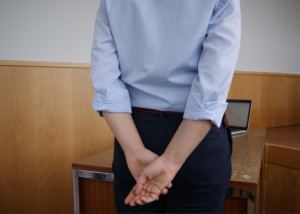The poem titled ‘A Farewell to Arms’ by the Englishman George Peele is about the loyalty of an aging knight to his queen. In his successful novel of the same name, published in 1929, Ernest Hemingway tells of Henry Barkley, who turns away from the war out of love for nurse Catherine. Hemingway counteracts the horrors of WWI with a poignant love story, a rejection of war and violence.
The title is the starting point for the juxtaposition of Alejandro Vidal and Ryszard Waśko, who both deal not only with national identity and its potential for conflict but also address social and religious isolation and its expression in everyday culture. In our perception, the term ‘the jungle’ is associated with a deserted paradise, with pure nature, while the law of the jungle is understood to mean a place where the law of the fittest prevails. In his series ‘Paradise of Exception,’ Vidal shows us a jungle landscape full of wild, impenetrable vegetation, with palm trees and a beach, an atmosphere of naturalness, and peace.
read moreBut not only the black and white print of the work irritates and makes the viewer pause. The prints are based on reproductions of illustrations taken from Vidal field manuals of the American Army. Books that the soldiers used as a guidance system in the struggle for survival in the jungle. The jungle and its dichotomy between romance and danger, between color and black and white, find their expression in the make-believe world of the images from military manuals.
Vidal's video installation ‘Firestorm’ also plays with ambiguities. What you can see is a seemingly endless string of colorful fireworks, the sound of which unfolds parallel to its image. However, the longer you listen, the more deviations there are: What can be heard are the sounds of war and explosions from an unknown fight.
From the stationery found in the Iraqi embassy in East Berlin, which was abandoned during the Gulf War, Vidal took this English phrase: ‘Through your search for your enemies you will not find them’, which he now applied to the walls of the exhibition room in an in situ work.
Ryszard Waśko was already working with visual media such as film, photography, and video in the 1970s. In his conceptual, media-reflective work, he not only left the boundaries between the artistic genres behind but also repeatedly introduced scientific and mathematical methods into his work. Thus, the editing of his films and the design of his photographs were based on mathematical-geometric principles.
In the work ‘Hypothetical Photography’, created in 1977, Waśko inserted a black and white image of the street into a coordinate system and translated it into a graphic scheme in his drawings, a processing of the photograph that ultimately leads him to a single straight line. In 1987 Waśko took up this idea for his work ‘Hypothetical Checkpoint Charlie’. In a mathematical, geometric, analytical, and destructive process, he dissolves the photographic depiction of ‘Checkpoint Charlie’ in his drawings until the object again disappears in straight lines.
As early as 1987, the work ‘Hypothetical Checkpoint Charlie’ heralds the dissolution of an obsolete Cold War monument in which violence, aggression, and oppression seemed to be stuck forever in concrete. On November 10, 1989, Waśko photographed the now open Checkpoint Charlie again and combined the photographs and drawings into the installation shown in the current exhibition.
In his work ‘No-man’s Land Flags’ from 1997, Waśko presents imaginary flags made up of different colors and shapes, thereby addressing the artificial and often deliberate construction of national identities.
The premises of the exhibition room, an old apartment into whose walls’ history seems to be written, give the exhibition an atmosphere of a deserted place, a place as we know it from pictures from war zones and scenes of violence.
read less







